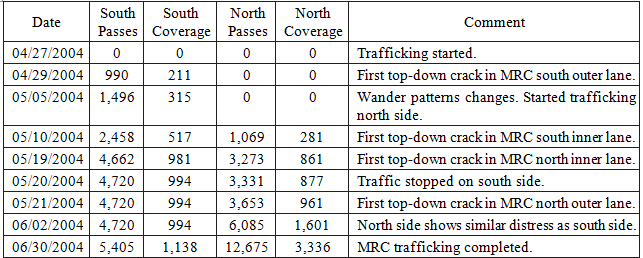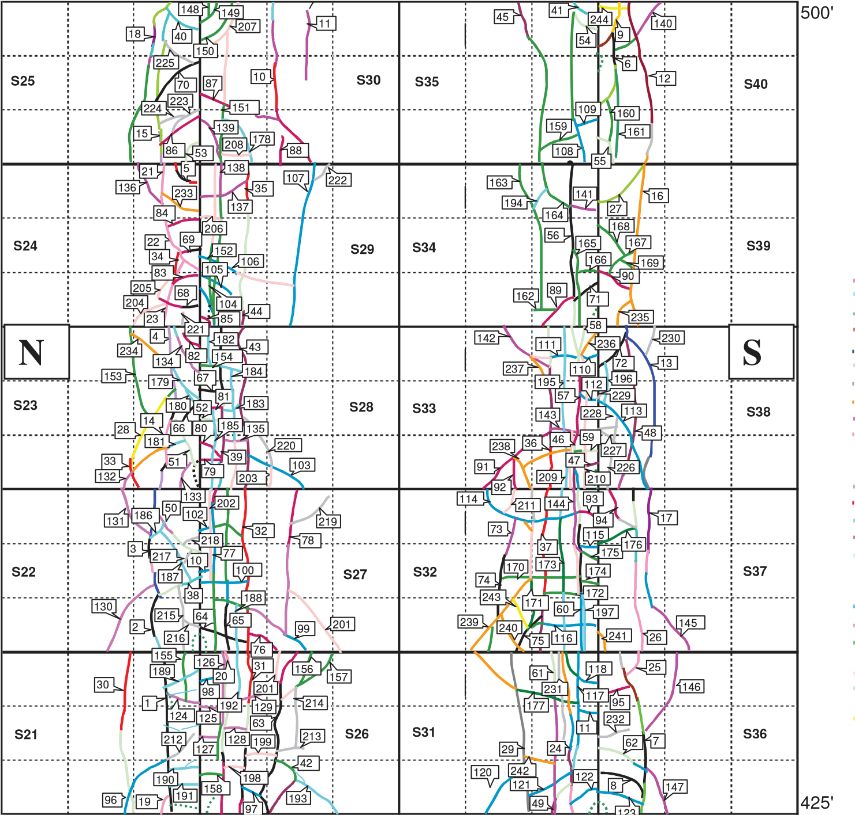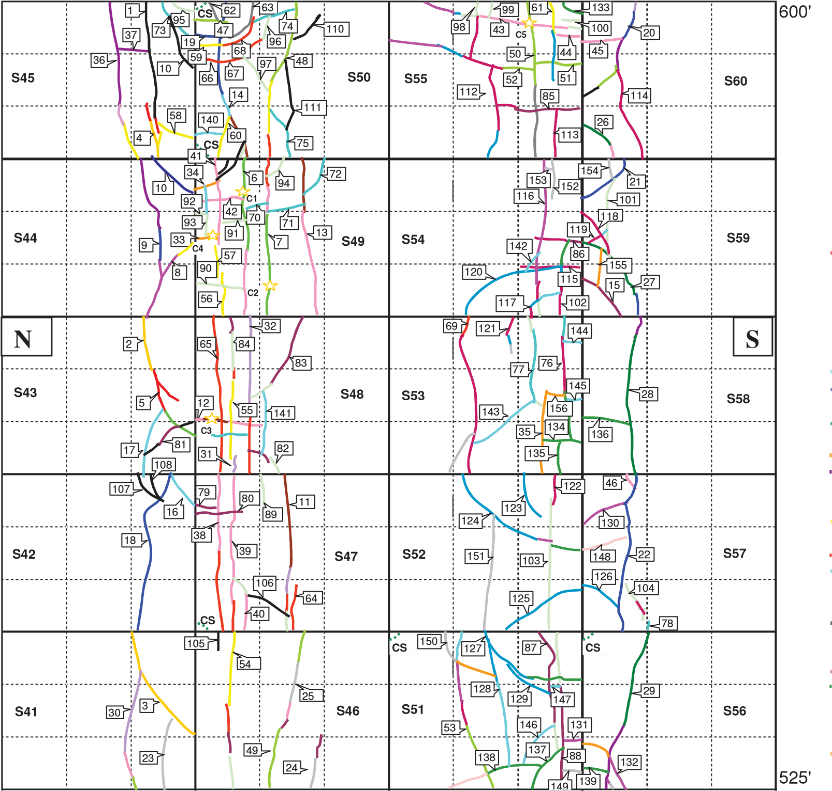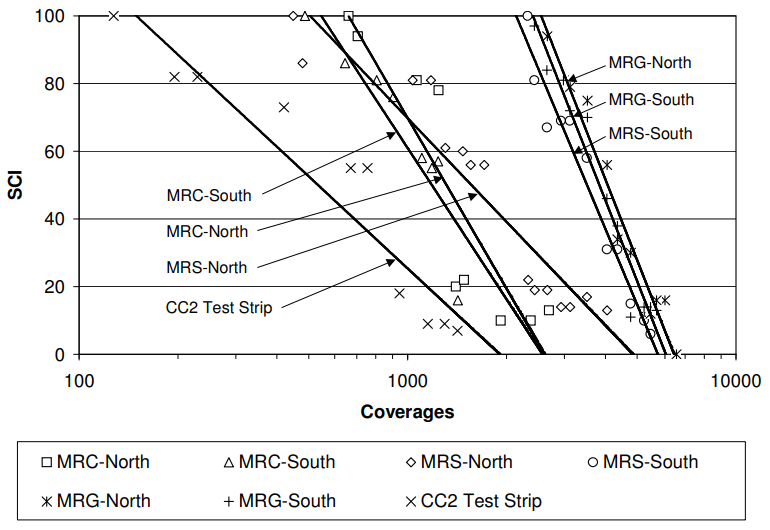CC2 Phase IV Test Results and Analysis
Original plans for trafficking considered 6-wheel loading (north side) and 4-wheel loading (south side) with 55,000 lbs. (24,950 kg) per wheel at speed 2.5 mph (4 km/h) and standard wander pattern of 66 passes per cycle. The pass-to-coverage ratio (P/C) was 4.71 for both 4-wheel and 6– wheel gear configuration. However, due to the variable flexural strength of the built test items: MRC - 744 psi (5.13 MPa), MRG - 833 psi (5.74 MPa) and MRS - 691 psi (4.77 MPa) and the short life predicted by FAA design procedures, it was decided to first test only MRC south under 55,000 lbs. (24,950 kg) and 4-wheel load. Several methods were used to monitor the performance of the CC2 Phase IV during trafficking:
- The structural response of the pavement to traffic loading was monitored continuously using embedded sensors. Instrumentation included concrete strain gages, and horizontal and vertical deflection transducers. Anomalous responses from strain gages can indicate the presence of a crack in a concrete slab before it propagates to the surface and becomes visible. Instrumentation data can be accessed here.
- Visual surveys of the pavement surface were performed. A set of detailed distress maps of each test item were prepared and can be accessed here.
- Curling was monitored through the use of VDT readings at slab corners and interiors, as well as visual observation of slab displacement or rocking.
Failure was considered to have occurred when a “shattered” slab condition (slabs broken into 6 or more pieces) was observed.
Trafficking Test on MRC Test Item
On April 27, 2004 traffic testing was conducted on MRC to observe the effect of the heavy wheel load on the new rigid pavement. Initially only the SWT of MRC was trafficked using the standard wander pattern with 66 passes. At about 400 passes, bottom-up cracks, perpendicular to the longitudinal joint, were detected by the CSG’s. Prior to these cracks reaching the slab surface, top-down cracks were observed in four out of five outer-lane slabs in the south side of MRC. Since the effect of outer-lane top-down cracks on the initiation/development of the inner-lane bottom-up cracks was unclear, the wander pattern for the NWT of MRC was modified to eliminate direct loading of the outer lane slabs, maintaining the 4-wheel gear loading.
The modified wander pattern did not consider trafficking on the outer slabs of the NWT (Positions -1 through -4 were removed from the wander pattern) and the number of passes was increased to match the number of repetitions at critical locations (76 passes). The abbreviated wander pattern was used to traffic the NWT (P/C = 3.80) while the original wander pattern, increased by 10 passes to match the number of passes in the modified wander, was used to continue trafficking the SWT of MRC (P/C = 4.74). Figure 2 presents the final distress map and Table 1 the summary of events for the MRC test item.
Table 1. Summary of Traffic Events for MRC Test Item


Figure 2. MRC Distress Map After 12,675 Passes on North Side (4-wheels) and
5,405 on South Side (4-wheels)
Trafficking MRG and MRS Test Items
MRG and MRS were trafficked using the following parameters:
(1) Six-wheel loading in the north lane and four-wheel loading in the south lane, with a wheel load of 55,000 lbs. (24,950 kg), to compare the effect of the load configuration on pavement life;
(2) Standard wander pattern of 66 passes per wander cycle (Figure 1). The carriages were positioned with the zero wander position having the outer sets of wheels on the inner slab lanes and adjacent to the longitudinal joints between the inner and outer slab lanes. The north and south carriages were programmed to move together, with the same distance held between the carriages, at all times;
(3) since frequent watering was successful in maintaining the slabs nearly flat in MRC, it was continued for the duration of the trafficking on MRG and MRS. MRG and MRS were trafficked between July 6 and December 10, 2004. Distress maps were kept updated for each test item during trafficking with comments of significant events. The final distress maps for MRG and MRS are shown in Figures 3 and 4 respectively. Tables 2 and 3 present a summary of the significant events during trafficking of the MRG and MRS test items.

Figure 3. MRG Distress Map After 31,020 Passes on North Side (6-wheels) and 30,996 on South Side (4-wheels)
Table 2. Summary of Traffic Events for MRG Test Item


Figure 4. MRS Distress Map After 20,262 Passes on North Side (6-wheels) and 30,996 on South Side (4-wheels)
Table 3. Summary of Traffic Events for MRS Test Item

The CC2 Phase IV test sections were then evaluated using the structural condition index (SCI). The specific distresses included in the calculation of SCI were corner breaks; linear cracks; shattered slabs; and shrinkage cracks. The measured SCI values were then related to the prediction models used in the LEDFAA design procedure. It was found that the MRC and MRS test sections exhibited crack initiation earlier than the MRG sections. However, the MRG sections experienced pavement deterioration at a quicker rate than the other test sections, with the exception of MRS-South.
|
Test Section
|
Coverages to Initial Crack, C 0
|
Coverages to Initial Crack, C f
|
Pass to Coverage Ratio
|
|
MRC-North
|
661
|
2613
|
3.80
|
|
MRC-South
|
546
|
2576
|
4.71
|
|
MRG-North
|
2551
|
6480
|
|
MRG-South
|
2408
|
6117
|
|
MRS-North
|
505
|
4855
|
|
MRS-South
|
2141
|
5784
|

Back to CC2 Phase IV Test Items